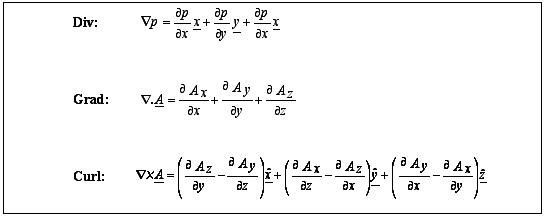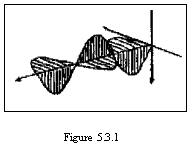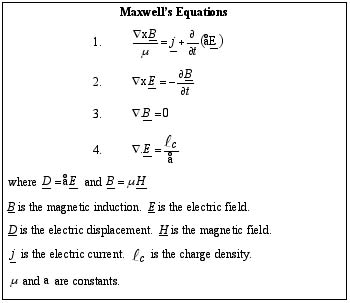James Clerk Maxwell - The Great Unknown
Kevin Johnson
The Electromagnetic Field
Maxwell's theory of electromagnetic radiation was without doubt his greatest piece of work. It revolutionarised the way we view the world, changing our perspective from Newton's purely mechanical model of differential equations, to a physical reality represented by continuous fields that were subject to partial differential equations.
The origin of this work can be traced back to 1820 and a classroom in Copenhagen where Hans Christian Oersted, professor of physics, conducted an experiment that illustrated the connection between electricity and magnetism. These results sparked experiments across the globe as scientists attempted to find an explanation. The favoured explanation, which was provided by Ampere, was that central forces were the cause.
However, in London, Michael Faraday was constructing his own experiments based on Oersted's work. He converted electric energy into mechanical energy for the first time and produced the first dynamo to do the opposite. It was in 1831, though, that Faraday made his most renowned experiment demonstrating electromagnetic induction by winding insulated wire around one side of an iron ring and connecting a second winding on the other side to a galvanometer. He noted that when a current started or stopped flowing through the first wire a second current could be noted in the second wire. Faraday explained these results not by central forces but by lines of force.
By 1850 Faraday had completed much of his work but the majority of scientists had failed to realise its significance. Maxwell was one of the minority that did. In 1856, he published a paper On Faraday's Lines of Force in which he compared the behaviour of the lines of force to the flow of a liquid and derived equations that represented electric and magnetic effects.
He published his second paper in 1862 On Physical Lines of Force which was mainly concerned with constructing a model for the medium (known as the ether) that would account for the electric and magnetic effects. Using this model he considered the electromagnetic wave and found that its speed would be equal to the ratio of the value for an electric current measured in electrostatic units to the value of the same current measured in electromagnetic units:
This ratio had been calculated to be the speed of light and so Maxwell drew the conclusion that:
In other words he suggested that light, an electric field and a magnetic field could all be explained in a single electromagnetic theory.
Maxwell's final paper on the subject, A Dynamical Theory of the Electromagnetic Field, was published in 1864. It was in this that he first defined the famous operators, 'div' (the divergence of a flow), 'grad' (the gradient of a flow), and 'curl' (the amount of twist in a flow) shown below in their current form:

 He ignored his previous model for ether and concentrated on the propagation of electromagnetic waves through space. He developed equations to describe the electromagnetic field, which showed that light is propagated in two waves, electric and magnetic, which vibrate perpendicular to each other and to the direction in which they are moving (see figure 5.3.1).
He ignored his previous model for ether and concentrated on the propagation of electromagnetic waves through space. He developed equations to describe the electromagnetic field, which showed that light is propagated in two waves, electric and magnetic, which vibrate perpendicular to each other and to the direction in which they are moving (see figure 5.3.1).
Finally the three papers were grouped together in his book Treatise on Electricity and Magnetism published by Clarendon Press, Oxford, in 1873. It consisted of four parts - Electrostatics, Electrokinetics, Magnetism, and Electromagnetism - which were to be read concurrently. This book was a great inspiration to many scientists. It largely inspired Hertz's discovery of radio transmission in 1888, which sprung techniques in television, radar and microwaves.
It also contained for the first time in fully developed form, the partial differential equations now known as Maxwell's equations (displayed below in modern notation):

These equations were one of the greatest achievements of the nineteenth century. Even Einstein acknowledged that the special theory of relativity owes its origins to Maxwell's equations. He also said:
However Maxwell's theory was largely ignored for twenty years. A major reason for this was modesty. On making his discovery he did not proclaim it loudly to the rest of the world, rather he added on his ideas to a lecture he gave on a rival theory, Kelvin's vortices, saying
Maxwell did not even acknowledge it as being his own theory.
Additionally, the theory was very difficult to understand, which was compounded by a lack of experimental confirmation. Physicists found the mathematics too confusing and mathematicians struggled with the physical language used to explain it. For example, Sir William Thomson (a.k.a. Lord Kelvin) who, despite having done much work on the subject, could not comprehend Maxwell's work saying:
The problem was that the theory was incredibly difficult to visualise and it did not have any obvious advantage over Newtonian style explanations. In order to appreciate the work they had to accept the idea of the mechanical world that they knew, coexisting with the continuous field. This was too abstract for most and it took a generation before Maxwell's theory was widely used, prompting work from Einstein, Hertz and others. In 1887, Hertz finally achieved the sought after experimental confirmation.
It is only recently, looking back, that people have begun to realise the immense impact the theory had giving the basis for the development of the theory of quantum mechanics, along with many others. In the words of Richard P. Feynman, Nobel Laureate:
The origin of this work can be traced back to 1820 and a classroom in Copenhagen where Hans Christian Oersted, professor of physics, conducted an experiment that illustrated the connection between electricity and magnetism. These results sparked experiments across the globe as scientists attempted to find an explanation. The favoured explanation, which was provided by Ampere, was that central forces were the cause.
However, in London, Michael Faraday was constructing his own experiments based on Oersted's work. He converted electric energy into mechanical energy for the first time and produced the first dynamo to do the opposite. It was in 1831, though, that Faraday made his most renowned experiment demonstrating electromagnetic induction by winding insulated wire around one side of an iron ring and connecting a second winding on the other side to a galvanometer. He noted that when a current started or stopped flowing through the first wire a second current could be noted in the second wire. Faraday explained these results not by central forces but by lines of force.
By 1850 Faraday had completed much of his work but the majority of scientists had failed to realise its significance. Maxwell was one of the minority that did. In 1856, he published a paper On Faraday's Lines of Force in which he compared the behaviour of the lines of force to the flow of a liquid and derived equations that represented electric and magnetic effects.
He published his second paper in 1862 On Physical Lines of Force which was mainly concerned with constructing a model for the medium (known as the ether) that would account for the electric and magnetic effects. Using this model he considered the electromagnetic wave and found that its speed would be equal to the ratio of the value for an electric current measured in electrostatic units to the value of the same current measured in electromagnetic units:
This ratio had been calculated to be the speed of light and so Maxwell drew the conclusion that:
Light consists in transverse undulations of the same medium which is the cause of electric and magnetic oscillations. [27]
In other words he suggested that light, an electric field and a magnetic field could all be explained in a single electromagnetic theory.
Maxwell's final paper on the subject, A Dynamical Theory of the Electromagnetic Field, was published in 1864. It was in this that he first defined the famous operators, 'div' (the divergence of a flow), 'grad' (the gradient of a flow), and 'curl' (the amount of twist in a flow) shown below in their current form:

 He ignored his previous model for ether and concentrated on the propagation of electromagnetic waves through space. He developed equations to describe the electromagnetic field, which showed that light is propagated in two waves, electric and magnetic, which vibrate perpendicular to each other and to the direction in which they are moving (see figure 5.3.1).
He ignored his previous model for ether and concentrated on the propagation of electromagnetic waves through space. He developed equations to describe the electromagnetic field, which showed that light is propagated in two waves, electric and magnetic, which vibrate perpendicular to each other and to the direction in which they are moving (see figure 5.3.1).Finally the three papers were grouped together in his book Treatise on Electricity and Magnetism published by Clarendon Press, Oxford, in 1873. It consisted of four parts - Electrostatics, Electrokinetics, Magnetism, and Electromagnetism - which were to be read concurrently. This book was a great inspiration to many scientists. It largely inspired Hertz's discovery of radio transmission in 1888, which sprung techniques in television, radar and microwaves.
It also contained for the first time in fully developed form, the partial differential equations now known as Maxwell's equations (displayed below in modern notation):

These equations were one of the greatest achievements of the nineteenth century. Even Einstein acknowledged that the special theory of relativity owes its origins to Maxwell's equations. He also said:
This change in the conception of reality is the most profound and the most fruitful that physics has experienced since the time of Newton. [13, p71]
However Maxwell's theory was largely ignored for twenty years. A major reason for this was modesty. On making his discovery he did not proclaim it loudly to the rest of the world, rather he added on his ideas to a lecture he gave on a rival theory, Kelvin's vortices, saying
... another theory of electricity which I prefer ... [12].
Maxwell did not even acknowledge it as being his own theory.
Additionally, the theory was very difficult to understand, which was compounded by a lack of experimental confirmation. Physicists found the mathematics too confusing and mathematicians struggled with the physical language used to explain it. For example, Sir William Thomson (a.k.a. Lord Kelvin) who, despite having done much work on the subject, could not comprehend Maxwell's work saying:
I never satisfy myself unless I can make myself a mechanical model of a thing. If I can make a mechanical model I can understand it. [27]
The problem was that the theory was incredibly difficult to visualise and it did not have any obvious advantage over Newtonian style explanations. In order to appreciate the work they had to accept the idea of the mechanical world that they knew, coexisting with the continuous field. This was too abstract for most and it took a generation before Maxwell's theory was widely used, prompting work from Einstein, Hertz and others. In 1887, Hertz finally achieved the sought after experimental confirmation.
It is only recently, looking back, that people have begun to realise the immense impact the theory had giving the basis for the development of the theory of quantum mechanics, along with many others. In the words of Richard P. Feynman, Nobel Laureate:
From a long view of the history of mankind - seen from, say, ten thousand years from now - there can be little doubt that the most significant event of the 19th century will be judged as Maxwell's discovery of the laws of electrodynamics. [27]